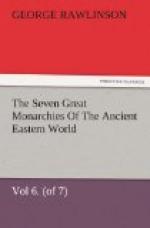The one certainly Parthian bas-relief is that which still exists on the great rock of Behistun, at the foot of the mountain, raised but slightly above the plain. It seems to have contained a series of tall figures, looking towards the right, and apparently engaged in a march or procession, while above and between them were smaller figures on horseback, armed with lances, and galloping in the same direction. One of these was attended by a figure of Fame or Victory, flying in the air, and about to place a diadem around his brow. The present condition of the sculpture is extremely bad. Atmospheric influences have worn away the larger figures to such an extent that they are discerned with difficulty; and a recent Governor of Kirmanshah has barbarously inserted into the middle of the relief an arched niche, in which he has placed a worthless Arabic inscription. It is with difficulty that we form any judgment of the original artistic merit of a work which presents itself to us in such a worn and mutilated form; but, on the whole, we are perhaps justified in pronouncing that it must at its best have been one of inferior quality, even when compared only with the similar productions of Asiatics. The general character is rather that of the Sassanian than of the Assyrian or Persian period. The human figures have a heavy clumsiness about them that is unpleasant to contemplate; the horses are rudely outlined, and are too small for the men; the figure of Fame is out of all proportion to the hero whom she crowns, and the diadem which she places on his head is ridiculous, being nearly as large as herself! On the other hand, there is spirit in the attitudes of both men and horses; the Fame floats well in air; and the relief is free from that coarse grotesqueness which offends us in the productions of the Sassanian artists.
Another, bas-relief, probably, but not quite certainly Parthian, exists in the gorge of Sir-pul-i-zohab, and has been recently published in the great work of M. Flandin. [PLATE VIII.] The inscription on this monument, though it has not yet been deciphered, appears to be written in the alphabet found upon the Parthian coins. The monument seems to represent a Parthian king, mounted on horseback, and receiving a chaplet at the hand of a subject. The king wears a cap bound round with the diadem, the long ends of which depend over his shoulder. He is clothed in a close-fitting tunic and loose trowsers, which hang down upon his boots, and wears also a short cloak fastened under the chin, and reaching nearly to the knee. The horse which he bestrides is small, but strongly made; the tail is long, and the mane seems to be plaited. Thus far the representation, though somewhat heavy and clumsy, is not ill-drawn; but the remaining figure—that of the Parthian subject—is wholly without merit. The back of the man is turned, but the legs are in profile; one arm is ridiculously short, and the head is placed too near the left shoulder. It would seem that the artist, while he took pains with the representation of the monarch, did not care how ill he rendered the subordinate figure, which he left in the unsatisfactory condition that may be seen in the preceding woodcut.




